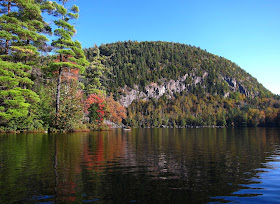There probably won't be too many more autumn days as lovely as Monday was. A bright sun burned off the fog that lay over Pyramid Lake and the rest of the north country this morning, and also quickly warmed the air from the 36 degrees Fahrenheit at dawn to a comfortable 60-ish by the time my pals Nancy Slack and Ruth Brooks joined me for a paddle on this pristine Adirondack wilderness lake.
Here's Nancy in her Kevlar Hornbeck canoe.
And here's Ruth in her inflatable canoe that she can pack in a bag and stow in her car's trunk.
As soon as we pushed off from shore, I led my friends down to the eastern end of the lake, paddling close to sun-warmed banks made brilliant with blueberry shrubs.
The eastern end of Pyramid Lake eventually narrows into a stream that penetrates deep into a cedar swamp. A fascinating feature of this swamp is that, while the sphagnum-carpeted banks support such acid-loving plants as cotton sedge, sundews, and cranberries, the water itself is basic, due to its underlying marble substrate.
As we moved through the shallow water of the swamp, our paddles stirred up uncountable numbers of Nostoc balls, colonies of cyanobacteria encased in pea-green gelatinous orbs. During the chill of the night, the Nostoc balls had sunk to the muddy bottom, but as the sun warmed the water, they began to rise closer to the surface.
Recent heavy rains had raised the water level enough that the extensive patches of Small Bur-reed (Sparganium natans) that thrive in this lake were completely submerged. Normally, at this time of year, the spiky seed heads of this emergent plant (rated as a Threatened species in New York State) would extend well above the water.
Nancy pulled one specimen of Small Bur-reed above the water so we could all have a better look at it.
Here's just one of the sphagnum-covered hummocks, this one displaying both red and green species of the moss.
Down under the shallow water, masses of the green alga called Chara carpeted the muddy bottom. Because of its branching structures and green color, this alga resembles a land plant, but it is found only submerged in fresh water, particularly in lime-enriched areas of the northern temperate zone. This alga feels rough to the touch because of calcium deposits on the cell walls, and the metabolic processes associated with this deposition often give Chara a distinctive smell of hydrogen sulfide. This odor suggested one of this alga's common names, which is Muskgrass. And yes, the odor was immediately detectable, as I pulled a few pieces up from the bottom to more closely examine them.
While the foliage of trees surrounding the lake was beginning to fade from the apex of its brilliance, the leaves of Marsh Cinquefoil (Comarum palustre) lining the shore remained as vivid as ever.
I love this image of Nancy and Ruth comparing their bryophyte finds! And there certainly were lots of mosses and liverworts to be found in this shallow end of the lake. I am so very grateful for such knowledgeable (and also delightful!) friends like these, who can teach me so much about the natural wonders we find together.
Before our visit to Pyramid Lake was complete, I urged my friends to paddle over beneath the cliffs, where the sheer rock face of Bear Mountain rises dramatically from the water's edge. Ravens often roost on these craggy cliffs, and a pair of them loudly announced our presence as we approached the mountain. Ruth recorded their calls on her cell phone, and entered into conversation with the Ravens as she played the calls back and the birds responded. I was struck by how the calls echoed across the surrounding mountains, especially since I had earlier noted the absolute silence we had encountered here as we first set off across the lake's quiet water.
An afternoon breeze had come up, to ripple the water and set the trees to whispering. The gentle lapping of wavelets against our boats and the sighing pines seemed to be begging us to stay, but other obligations called us home, sorry to leave but filled with gratefulness that such perfect beauty was ours to enjoy any time we wished to return.
I still had one more stop to make before returning home. There are marble boulders that line the entrance road to Pyramid Lake, and each spring I find those boulders adorned with the beautiful tissue-thin flowers of American Purple Clematis (Clematis occidentalis). I wondered if I would find their fluffy and curvaceous seed heads at this time of year. As this photo reveals: yes, I did!















Thank you, Jackie. Your most welcomed post filled up "my cup" to overflowing this morning!
ReplyDeleteYou know amazing and magical things and take incredible photos! Thank you for sharing this beauty!
ReplyDeleteAs always your postings are so full of wonder and so encouraging as to invite us to learn more about the native beauty around us! Thank you.
ReplyDeleteThat is certainly a beautiful lake. I envy you for living in such a beautiful area.
ReplyDelete